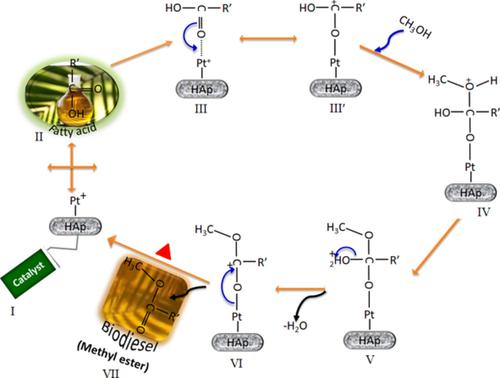当前位置:
X-MOL 学术
›
Can. J. Chem. Eng.
›
论文详情
Our official English website, www.x-mol.net, welcomes your
feedback! (Note: you will need to create a separate account there.)
Nano‐hydroxyapatite (HAp) and hydroxyapatite/platinum (HAp/Pt) core shell nanorods: Development, structural study, and their catalytic activity
The Canadian Journal of Chemical Engineering ( IF 1.6 ) Pub Date : 2020-07-07 , DOI: 10.1002/cjce.23840 Manoj Murugesan 1, 2 , Venkatesan Krishnamurthy 3 , Neha Hebalkar 4 , Mangalaraj Devanesan 1 , Ponpandian Nagamony 1 , Meena Palaniappan 5 , Swaminathan Krishnaswamy 3 , Aihua Yuan 2
The Canadian Journal of Chemical Engineering ( IF 1.6 ) Pub Date : 2020-07-07 , DOI: 10.1002/cjce.23840 Manoj Murugesan 1, 2 , Venkatesan Krishnamurthy 3 , Neha Hebalkar 4 , Mangalaraj Devanesan 1 , Ponpandian Nagamony 1 , Meena Palaniappan 5 , Swaminathan Krishnaswamy 3 , Aihua Yuan 2
Affiliation

|
The development of a new kind of material that is a nanostructured catalytic material with an environmentally benign nature that can be used for alternative energy has acquired significance in recent years. In this context, the use of heterogeneous catalysts for the transesterification of vegetable oils has gained prominence due to their eco‐friendly and reusable nature. Hence in the present study, pure hydroxyapatite (HAp) and hydroxyapatite/platinum (HAp/Pt) nanostructured particles have been prepared successfully through a facile chemical method without templates and surfactants and their catalytic activity investigated for transesterification of natural vegetable oil to bioenergy (biodiesel). The textural and structural features of pure HAp and HAp/Pt were investigated using various characterization techniques such as x‐ray diffraction, Fourier transform infrared (FTIR) and Raman spectroscopy, field emission scanning electron microscopy (FESEM), and transmission electron microscopy (TEM). The elements present in the prepared nanostructures were confirmed through energy dispersive spectroscopy (EDS) and x‐ray photoelectron spectroscopy (XPS) techniques. The XPS analysis also confirms the metallic nature of the platinum in HAp/Pt. The specific surface area and porous nature of the prepared nanostructured catalysts were studied using the N2 physisorption Brunauer‐Emmett‐Teller‐Barrett‐Joyner‐Halenda (BET‐BJH) method. The catalytic activity of the pure HAp nanoparticles and HAp/Pt core shell nanorods with the Simarouba glauca plant seed oil was investigated. The obtained results indicate that the pristine HAp nanoparticles and HAp/Pt core shell nanorods (NRs) show 91.4% and 87.1% fatty acid methyl ester (FAME) conversion, respectively, potentially offering environmental benign biocatalysts for biofuel production from natural feed stock.
中文翻译:

纳米羟基磷灰石(HAp)和羟基磷灰石/铂(HAp / Pt)核壳纳米棒:研发,结构研究及其催化活性
近年来,作为具有环境友好性质的可用于替代能源的纳米结构催化材料的新型材料的开发具有重要意义。在这种情况下,由于非均相催化剂具有生态友好性和可重复使用性,因此在植物油的酯交换反应中使用非均相催化剂已成为一个重要问题。因此,在本研究中,已经通过不使用模板和表面活性剂的简便化学方法成功地制备了纯羟基磷灰石(HAp)和羟基磷灰石/铂(HAp / Pt)纳米结构颗粒,并研究了它们的催化活性,以将天然植物油酯交换为生物能(生物柴油)。 )。使用各种表征技术,例如X射线衍射,纯净HAp和HAp / Pt,研究了其结构和结构特征。傅里叶变换红外(FTIR)和拉曼光谱,场发射扫描电子显微镜(FESEM)和透射电子显微镜(TEM)。制备的纳米结构中存在的元素通过能量色散光谱(EDS)和X射线光电子能谱(XPS)技术得到确认。XPS分析还证实了HAp / Pt中铂的金属性质。使用N研究了制备的纳米结构催化剂的比表面积和多孔性 XPS分析还证实了HAp / Pt中铂的金属性质。使用N研究了制备的纳米结构催化剂的比表面积和多孔性 XPS分析还证实了HAp / Pt中铂的金属性质。使用N研究了制备的纳米结构催化剂的比表面积和多孔性2物理吸附Brunauer-Emmett-Teller-Barrett-Joyner-Halenda(BET-BJH)方法。研究了纯HAp纳米颗粒和HAp / Pt核壳纳米棒对Simarouba glauca植物种子油的催化活性。获得的结果表明,原始的HAp纳米颗粒和HAp / Pt核壳纳米棒(NRs)分别显示91.4%和87.1%的脂肪酸甲酯(FAME)转化率,有可能为从天然原料生产生物燃料提供环境友好的生物催化剂。
更新日期:2020-07-07
中文翻译:

纳米羟基磷灰石(HAp)和羟基磷灰石/铂(HAp / Pt)核壳纳米棒:研发,结构研究及其催化活性
近年来,作为具有环境友好性质的可用于替代能源的纳米结构催化材料的新型材料的开发具有重要意义。在这种情况下,由于非均相催化剂具有生态友好性和可重复使用性,因此在植物油的酯交换反应中使用非均相催化剂已成为一个重要问题。因此,在本研究中,已经通过不使用模板和表面活性剂的简便化学方法成功地制备了纯羟基磷灰石(HAp)和羟基磷灰石/铂(HAp / Pt)纳米结构颗粒,并研究了它们的催化活性,以将天然植物油酯交换为生物能(生物柴油)。 )。使用各种表征技术,例如X射线衍射,纯净HAp和HAp / Pt,研究了其结构和结构特征。傅里叶变换红外(FTIR)和拉曼光谱,场发射扫描电子显微镜(FESEM)和透射电子显微镜(TEM)。制备的纳米结构中存在的元素通过能量色散光谱(EDS)和X射线光电子能谱(XPS)技术得到确认。XPS分析还证实了HAp / Pt中铂的金属性质。使用N研究了制备的纳米结构催化剂的比表面积和多孔性 XPS分析还证实了HAp / Pt中铂的金属性质。使用N研究了制备的纳米结构催化剂的比表面积和多孔性 XPS分析还证实了HAp / Pt中铂的金属性质。使用N研究了制备的纳米结构催化剂的比表面积和多孔性2物理吸附Brunauer-Emmett-Teller-Barrett-Joyner-Halenda(BET-BJH)方法。研究了纯HAp纳米颗粒和HAp / Pt核壳纳米棒对Simarouba glauca植物种子油的催化活性。获得的结果表明,原始的HAp纳米颗粒和HAp / Pt核壳纳米棒(NRs)分别显示91.4%和87.1%的脂肪酸甲酯(FAME)转化率,有可能为从天然原料生产生物燃料提供环境友好的生物催化剂。











































 京公网安备 11010802027423号
京公网安备 11010802027423号